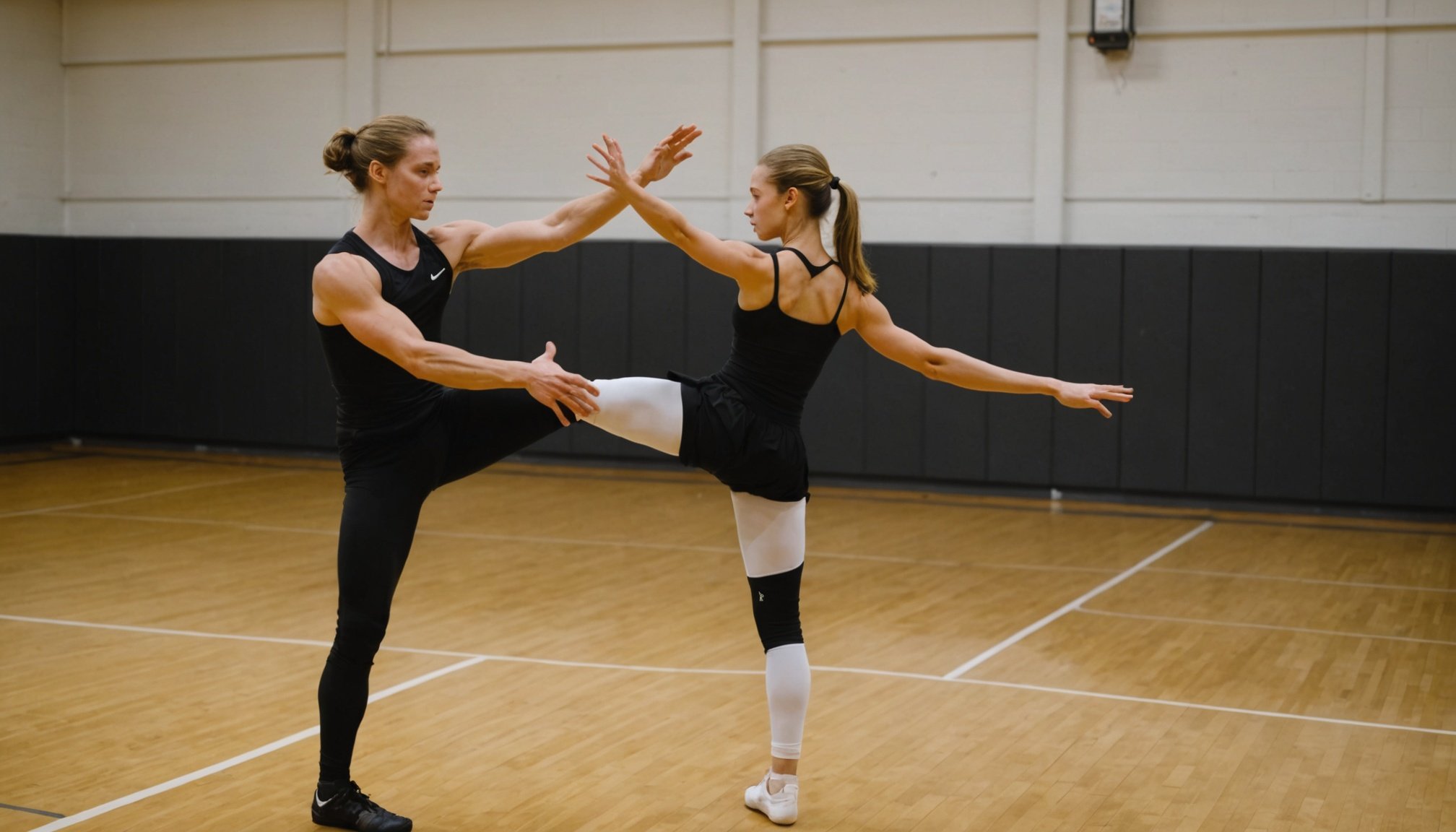Understanding Overuse Injuries in Dance
Overuse injuries are prevalent in dance due to repetitive strain on specific body parts. These injuries occur when structures are subjected to ongoing stress without adequate recovery time. Common types include tendonitis, stress fractures, and bursitis. Dancers frequently experience these ailments in their lower limbs, such as shin splints or Achilles tendonitis, resulting from exhaustive rehearsals and inadequate technique.
Dance injuries often arise from improper posture or technique during movements. As dancers aim for perfection, the pressure to perform flawless techniques can inadvertently lead to injury. Rehearsals focusing on mastering these techniques can further exacerbate the risk by increasing repetitive movement without integrating sufficient rest periods.
Have you seen this : Unleashing velocity: essential breathing strategies for swimmers to reduce drag and enhance speed
Recognizing signs and symptoms early is crucial. Symptoms like persistent pain, swelling, or restricted range of motion should not be ignored. These can be indicators of impending overuse injuries. It’s vital to implement prevention strategies, which include cross-training, ensuring proper warm-up routines, and incorporating rest days into training schedules. These strategies help maintain dancers’ physical health while allowing them to perform at their peak. By understanding the dynamics of dance injuries, dancers can effectively employ measures to reduce their occurrence while enhancing their performance.
Importance of Conditioning for Dancers
In the world of dance, conditioning strategies play a pivotal role. They are essential not only for enhancing performance but also for injury prevention. Dancers face physical demands that require a combination of strength, flexibility, and endurance. Integrating conditioning into their routine helps ensure they meet these demands effectively.
Also read : Fueling victory: how sports nutrition drives athletic excellence in competitive events
Conditioning enhances a dancer’s ability by focusing on stamina, muscle strength, and joint stability. These elements are crucial for executing complex movements smoothly and efficiently. Additionally, by improving overall physical competence, dancers reduce the risk of injuries that can arise from inadequate preparation.
The link between conditioning and injury prevention cannot be overstressed. A well-conditioned dancer is less likely to suffer from common dance-related injuries such as sprains, strains, and fatigue fractures. Such strategies incorporate tailored exercises that focus on strengthening muscles, tendons, and ligaments, proving invaluable over time.
Moreover, the long-term health benefits of conditioning are profound. Proper conditioning practices ensure sustained dancer health, allowing them to enjoy a prolonged and healthy dance career. Regular conditioning also promotes better posture and muscle balance, which are critical components of maintaining overall health and well-being in the physical demanding field of dance.
Key Conditioning Strategies for Injury Prevention
Injury prevention strategies are crucial for dancers to maintain their health and performance. Conditioning exercises form the backbone of these strategies, bolstering dancer fitness and reducing injury risk.
Warm-up Techniques
Dynamic stretching plays a vital role in warm-up techniques for dancers. Unlike static stretches, dynamic exercises prepare the body by increasing blood flow and improving range of motion. Recommended warm-up exercises for dancers include leg swings, lunges, and arm circles. These movements should be done for about 5-10 minutes before every dance session to prepare muscles effectively.
Strength Training
Strength training is equally important in injury prevention strategies. Exercises like squats, planks, and calf raises build essential strength in muscles used predominantly in dance. Tailoring these exercises to specific dance styles enhances effectiveness. For instance, ballet dancers might focus on leg strength, while contemporary dancers could benefit from core stabilization. This type of training helps to reinforce muscles and joints, thus preventing common dance-related injuries.
Flexibility and Mobility Work
Dancer fitness regimes must include flexibility exercises to prevent injuries. Incorporating practices such as yoga and Pilates into routines boosts flexibility. Mobility work, focused on joint health and movement range, enhances flexibility and supports overall injury prevention strategies. Regular commitment to these practices optimizes performance and protects against overuse injuries.
Recovery Techniques to Support Conditioning
Focusing on recovery techniques is essential in a dancer’s routine to ensure optimal performance and prevent injuries. Post-performance care can significantly enhance dancer wellness by promoting muscle repair and reducing fatigue. Incorporating active recovery techniques, such as light stretching and yoga, can help maintain flexibility and prevent stiffness. Engaging in low-intensity exercises boosts blood circulation, aiding in the faster removal of metabolic waste.
Dancer wellness also heavily relies on the role of nutrition and hydration in recovery. Optimal nutrition provides necessary energy and repairs tissues. Consuming a balanced diet rich in proteins, carbohydrates, and fats post-performance can help restore glycogen and promote muscle synthesis. Hydration is equally important, as it regulates body temperature and maintains joint functionality, thus making it a critical aspect of post-performance care.
Additionally, employing varied recovery techniques such as massage and foam rolling can alleviate muscle soreness. These methods are instrumental in stretching fascia and improving tissue extensibility. Cold therapy and compression garments are also beneficial for reducing inflammation. By integrating these diverse post-performance care strategies, dancers can enhance their wellness and prolong their professional longevity.
Expert Insights and Case Studies
Seeking expert advice from physiotherapists specializing in dance can be invaluable for injury prevention. These professionals bring a wealth of knowledge, not only about common injuries but also tailored strategies that cater to the unique demands of dance. By understanding the physiological stresses and patterns dancers encounter, physiotherapists can recommend specific exercises and routines that help in strengthening muscles, increasing flexibility, and enhancing overall performance.
Injury prevention case studies offer real-world examples of effective strategies at work. Consider a study in which a dance troupe reduced injuries by 30% over a year by integrating a targeted warm-up routine. This involved dynamic stretching and conditioning exercises, recommended by expert physiotherapists, proving that simple changes based on expert advice can have a profound impact.
Testimonials from dancers further underscore these benefits. One dancer shared how adopting a personalized prevention plan greatly reduced their ankle sprains, a common issue among performers. Embracing expert guidance not only helps prevent injuries but empowers dancers with the confidence to perform optimally.
Creating a Personalized Conditioning Plan
Designing a personalized conditioning plan is vital for any individual’s fitness journey, mainly when focusing on activities like dance that require unique skills and agility. Tailored training begins with evaluating the dancer’s current fitness levels, which helps in identifying specific physical needs and capabilities. This assessment forms the foundation for setting realistic goals, a crucial step in ensuring long-term success and maintaining dancer safety.
Setting achievable objectives involves considering both short-term targets and long-term aspirations. This clearly defines the path forward, ensuring every exercise and regimen aligns with the dancer’s ultimate goals. It’s also essential to keep the conditioning plan dynamic, adapting it over time to match the dancer’s growing proficiency and changing priorities.
Regularly monitoring progress is equally important. Checking in on achievements allows for essential adjustments to the conditioning plan, ensuring it remains appropriately challenging and effective. One should consistently review and refine training sessions to prevent overstress or injury while maximising gains. This ongoing assessment and adjustment make sure the training remains tailored and focused on dancer safety. Proper planning and consistent evaluation forge a pathway to success, fostering both skill enhancement and physical well-being.











